Singaporeans Should Give a Damn About the Environment, and Other Things
We’re into the final quarter of the year with Hong Kong on our minds, wondering whether to cheer or commiserate knowing that Singapore should benefit from their demise and the billions that will flow in Singapore’s way as the unrest escalates.
 Source: Bloomberg
Source: Bloomberg
Yet, Singaporeans have other issues to worry about because somehow our S-Reits investments are entangled with WeWork’s messy failed IPO, and property defaults are expected to loom in the US.
Or should we be talking about basic civility, brought up by Dr Tommy Koh at the Singapore Bicentennial Conference this week? “I am more critical of Singaporeans than of the Government. Many of our people don’t give a damn for the environment when they should. Many of our people are selfish and unkind. Just look at the way they drive,” he commented.
 Source: ST
Source: ST
Oh yes, that is a home run statement for a good friend who was describing how she had to drive alongside a GrabCar to beg to be allowed to drive in her own lane on Holland Road towards Holland Village because she knew he was half-minded about drifting into her lane as his lane merged and she didn’t want to be unnerved yet again every four out of five days a week. Statistically, we counted around three dented dumpers out of every 10 private hire vehicles, with a record of five encounters in 15 minutes, along with side mirrors fallen out and scrapped sides.
No one is thinking much about the environment, Dr Koh, because we are “a tribe of people who are working insanely hard to keep pushing ahead”, or keep up perhaps, as Bloomberg’s editor-in-chief John Micklethwait said. And Hong Kong-ers are protesting because they now want their freedom, which is just too bad for the inferior lot on the mainland, who must feel denigrated by now.
But Dr Koh is spot on about the environment and that is what we intend to address today because it will be hitting our bottom lines in a bad way if we don’t watch it close enough and let ourselves put the pieces together as best as we can (before we talk about making money).
The Haze
 Source: Bloomberg
Source: Bloomberg
Damages:
- 1997 – 19,300 square miles and put 200,000 people in the hospital
- 2015 – The fires were responsible for 100,000 premature deaths and emitted more carbon on a daily basis than the entire EU
- 2019 – ?
As we mentioned last week, it is absurd that there would be massive wildfires raging at the same time on all the continents of Earth except the Antarctica, and yet we have it this year and it looks like an entire generation will be affected by what’s happening right now because air pollution particles may reach fetuses besides affecting the brain development (neurodegeneration) of children. It’s also linked to anxiety and suicidal thoughts in children and adults (mental well-being). There are long-term effects from the fires too.
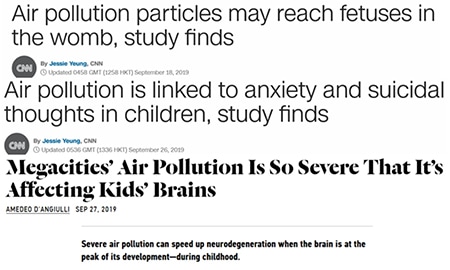 Source: CNN and Citylab.com
Source: CNN and Citylab.com
And to put it into perspective, it is also perhaps the reason that they can’t find for the falling IQ levels—Increased Pollution (including microplastics)! Does that not call for some empathy for the young protestors?
 Source: CNN
Source: CNN
If IQ levels are falling, then we cannot have much hope for a sensible future even if we are buying the best masks for our kids and feeding them organic beef.
Plastics
Breathing pollution is one thing. What about eating, drinking and breathing microplastics as we had ranted about last year in Trash Talking the Plastics Ban? And now we have come to accept that we’ve probably been having plastic for breakfast or ingesting at least 50,000 plastic particles a year. Even tea drinkers aren’t safe because a single tea bag can leak billions of microplastic pieces now?
 Source: CNN
Source: CNN
The fish have it a lot worse in the sea because the tides will after a while pummel plastics into nice-looking bits of fish-like edibles for the little fish. While the whales just gobble up the bags wholesale to die painful deaths, the little fish assimilate the plastic into their flesh for our dining pleasure as we continue to buy a bun for breakfast, consume it straightaway in less than five minutes and chuck the plastic aside for it has finished its purpose on earth (one-time use only!).
 Source: Quartz
Source: Quartz
It does not tie up to the big picture until we start to think about waste because the entire plastic life cycle contributes to global warming from its production to its disposal (except for those who are lucky enough to be eaten by fish and humans).
And global warming is a threat to fish, besides the rest of the 1 million species at risk of extinction due to human activities—land conversion, including deforestation, overfishing, bush meat hunting and poaching—climate change, pollution, and invasive alien species.
 Source: National Geographic
Source: National Geographic
Overpopulation
The haze, plastics, fish… it’s all due to the fact that we eat too much and the global food system contributes up to 37% of greenhouse gas emissions according to the UN’s Intergovernmental Panel for Climate Change (IPCC), although we are not sure if our local haze is considered part of the 37% because the land is indeed being BURNT TO PRODUCE HAZE to clear it for agricultural activities, possibly food-related, to feed the exploding population (except Singapore’s).
 Source: Wired
Source: Wired
Exploding population, as illustrated below. The world added nearly the entire population at 1900 between 2000 and 2019.
 Source: Twitter
Source: Twitter
Now we have a better idea of where all that demand came from to make us rich in our portfolios even though we are just starting to worry about sustainability and climate change, which affects sustainability and our children’s IQ levels with heightened anxiety thrown in to give rise to potential riots?
Is the economic threat of climate change understated? According to a paper following the work of Economics Nobel Prize winner William Nordhaus, who worked on the economics of climate change, “The biggest risks from climate change are associated with consequences that are unprecedented in human history and cannot simply be extrapolated from the recent past… These uncertainties mean that the impacts are difficult to represent in terms of costs and benefits and are therefore often ignored or omitted from economic models”. Yes, even economists are likely to ignore the potential losses in their models because it is too hard to figure (that everything is interlinked and there are too many variables to consider).
 Source: Barron’s
Source: Barron’s
But now we know that the haze is making us dumb; we are eating, drinking and breathing plastics which can’t be too good for the animals we eat too; and to top it off, sea levels are rising.
Rising Sea Levels
It is informally known as the Anthropocene, “a proposed epoch dating from the commencement of significant human impact on the Earth’s geology and ecosystems, including, but not limited to, anthropogenic climate change”, according to Wikipedia. Therefore, the burning, waste, plastic and extinction characterises this period we are living in.
As environmental historian and sociologist Jason Moore puts it in an interview on Wired, “Climate changes over the past 2,000 years have been extraordinarily destabilizing to ruling classes. This was the case for the Roman Empire in the West. So drought pushes the Huns, which pushes the Goths, they go into Western Europe. But more fundamentally, the changing climate after the year 400 creates all sorts of economic and political tensions, and in Western Europe, the Roman Empire collapses. We now understand that wasn’t a terrible thing, that in fact there was more equality, a lower birth rate. There were peasants reorganizing agriculture so that they depended on many different sources of food and had many different livelihood strategies, instead of just growing wheat for the Roman overlords”.
Perhaps it is acceptable in hindsight but surely not for those living in those times and it is even more reassuring to know that sea levels were 120 metres lower 20,000 years ago than they are today, rising quickly between 20,000 and 6,000 years ago before stabilising and rising just 18 cm in the last century. Estimates are for the seas to rise 20cm to 80 cm over the next century.
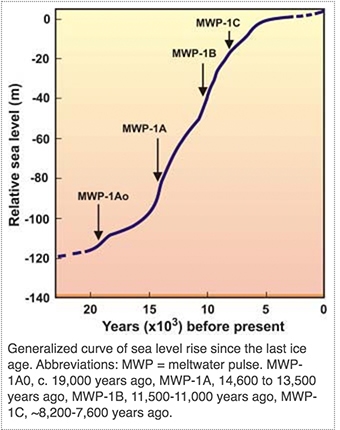 Source: NASA
Source: NASA
Climate Change and Real Estate
Why are we watching this “I lost my house to climate change” series on BBC?
Real estate matters because they are investments.
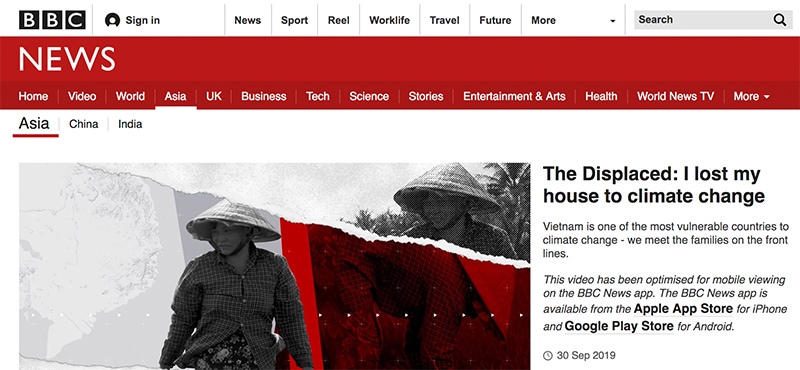 Source: BBC
Source: BBC
Even Singapore is prioritising, with Prime Minister Lee pledging “to spend $100 billion or more over the next 100 years to cope with current projected sea level rise of about 1m by 2100” to protect our precious real estate!
We watch the live action in Vietnam and Florida where, “By the end of the century, 13 million Americans will need to move just because of rising sea levels, at a cost of $1 million each, according to Florida State University demographer Mathew Haeur” as stronger storm surges due to fiercer hurricanes (due to warmer air) make the whole situation untenable, while there is plenty of hinterland left in America.
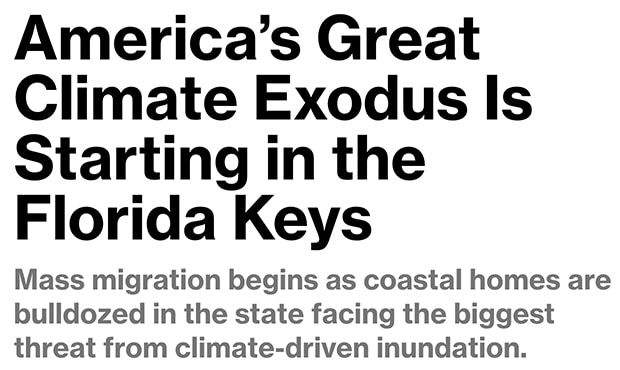 Source: Bloomberg
Source: Bloomberg
Singapore cannot take chances because there is no place to displace ourselves! Hence, “$100 bio or more”. Nonetheless, the main problem is what happens if the estimates are wrong? The calculations cannot be precise because the haze particles do travel around the world and get lodged in the ice (those fires in Siberia) causing the ice to absorb more heat (versus reflect heat when ice is white) and melt away faster. For instance, permafrost in the Arctic is estimated to be trapping 20-50% of carbon, which will increase the carbon in the atmosphere and accelerate warming.
Check out the correlation between carbon dioxide and the temperature over the past 400,000 years.
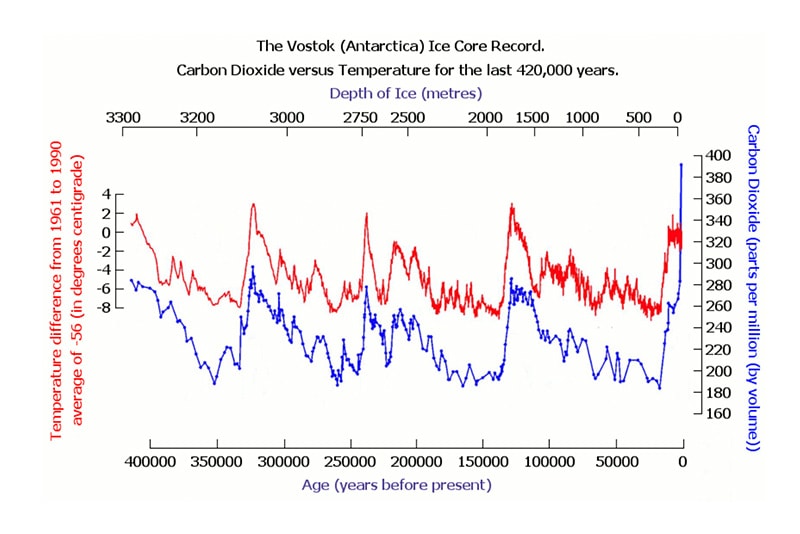 Source: Environmentcounts.org
Source: Environmentcounts.org
If they are wrong, the sea levels could rise faster than expected at a time when we have seven billion people in the world and, based on current estimates, about 200 million people would be affected by rising sea levels.
 Source: WEF
Source: WEF
This does not include the other victims of climate change in places like Malawi, battling droughts and floods.
Not counted in the 200 million estimate would probably be manmade sinking cities because building too much causes land to sink as we read about infrastructure projects stalling in nearby Bangkok and Jakarta (1m per decade) due to rising sea levels, groundwater depletion and too much building.
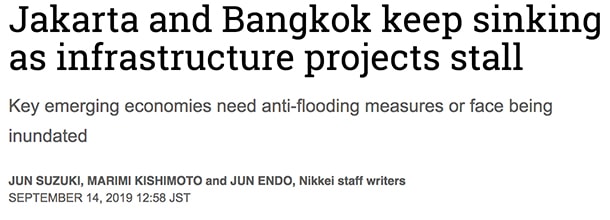 Source: Nikkei
Source: Nikkei
Singapore is safe as Bangkok Post helpfully pointed out, “Singapore does not face a direct threat of land subsidence from rising sea levels. In the worst-case scenario, if global temperatures increase by 4C and sea level rises 9.5m, 745,000 Singaporeans could be submerged, out of a population of 5 million. However, the government is all hands on deck in case to stop the country from sinking.”
To find the safest spots in Singapore that would not sink, we recommend this Wikipedia page on the Geology of Singapore.
And to think this was inspired by Dr Tommy Koh griping about Grab drivers and the need to worry about the environment which Russian President Putin is suddenly worried about too when he decided to join the Paris accords last month.
 Source: Bloomberg
Source: Bloomberg
What happens when everyone starts worrying at the same time?
Here are some interesting headlines popping up.
 Source: 7News
Source: 7News
 Source: Bloomberg
Source: Bloomberg
 Source: Automotive News Europe
Source: Automotive News Europe
 Source: Bloomberg
Source: Bloomberg
Do note that these do not constitute investment suggestions and do not take into account government and regulatory interventions in the market because who knows if the central banks will buy up the cars and if the governments will make Gucci the new uniform? After all, pollutant particles are making us dumber by the day and we are eating plastic in fish. The least we can do out of respect is not to waste food so maybe they do not need to burn more land to grow more food and convince you to get your own container for your breakfast bun. Then, maybe you would not feel so bad about buying Gucci afterward or worry about your property value in the name of global warming.
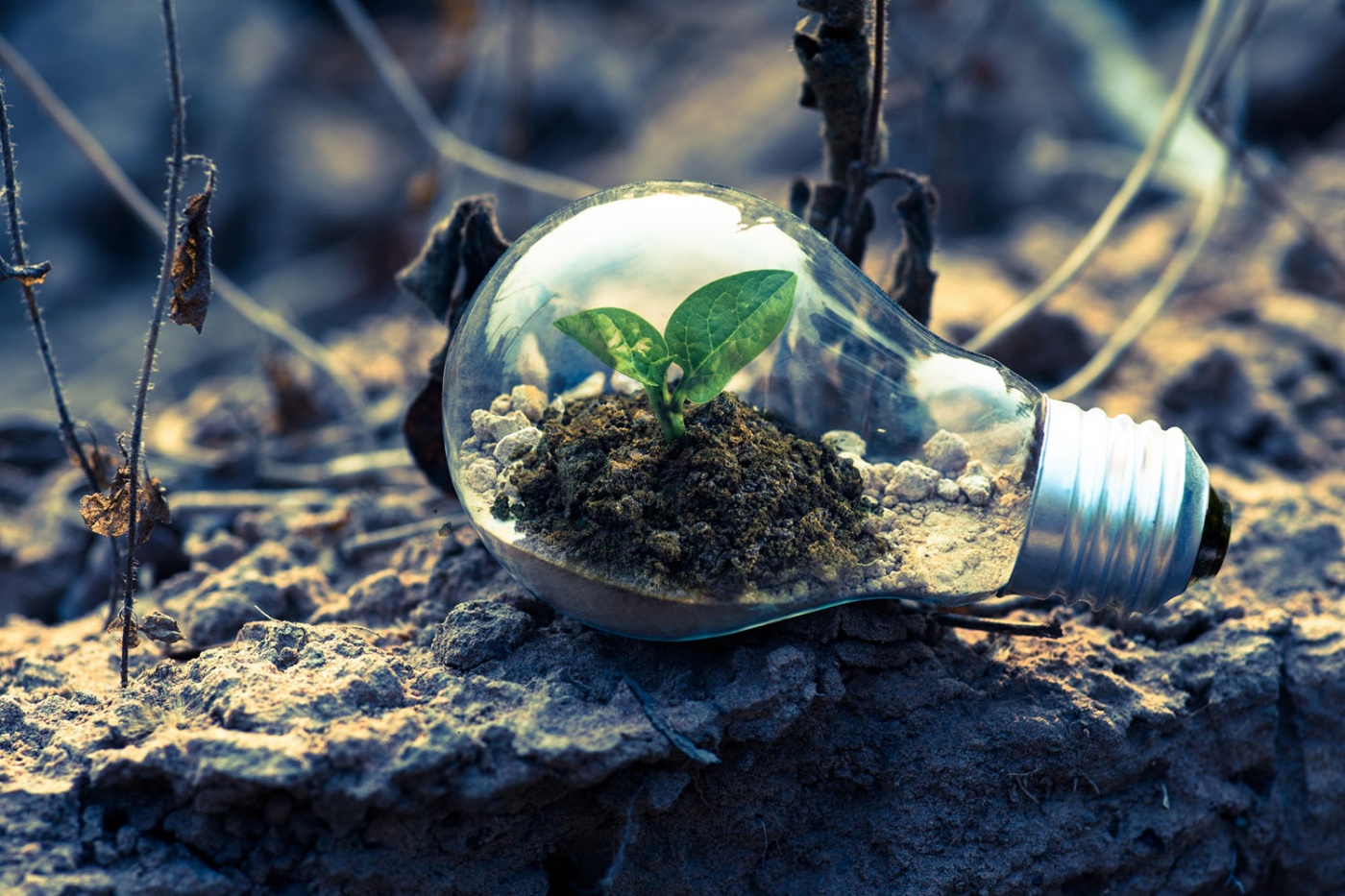
 Source:
Source: 
